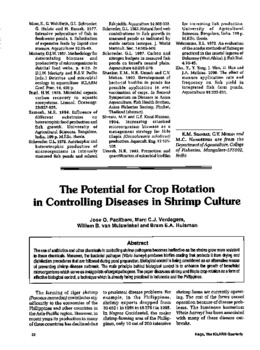The potential for crop rotation in controlling diseases in shrimp culture

Citation
Paclibare, J.O. et al. (1998). The potential for crop rotation in controlling diseases in shrimp culture. NAGA 21 (4): 22-24
The use of antibiotics and other chemicals in controlling shrimp pathogens become ineffective as the strains grow more resistant to these chemicals. Moreover, the bacterial pathogen (Vibrio harveyi) produced biofilm coating that protects it from dying and disinfection procedures that are followed during pond preparation. Biological control is being considered as an alternative means of preventing shrimp disease outbreak. The main principle behind biological control is to enhance the growth of beneficial microorganisms which serve as antagonists or target pathogens. The paper discusses shrimp and tilapia crop rotation as a form of effective biological control, a technique which is already being practiced in Indonesia and the Philippines.
Permalink
Date Available
Type
Publisher
Countries
Copyright
CC BY 4.0
Research Themes
Language